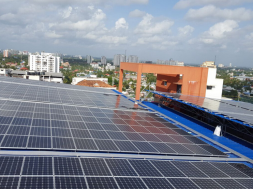
As India embarks on the path to economic recovery, business analysis and consulting firm PGA Labs has taken stock of the country’s power generation market and how it’s journey continues despite the crisis.
Compared to the economy at large, which has reportedly contracted by well over 20% in the second quarter of this year, India’s power generation market has escaped relatively unscathed according to the report. Prior to the crisis, India was already on course to meeting its generation targets, having already met 99% of the capacity requirements.
Generation capacity has been climbing steadily over the last decade and more, growing at a CAGR of more than 8% between 2006 and 2019. Thermal power has remained the dominant force here, although the last few years have seen renewable energy gradually amass a bigger piece of the pie.
This is only set to continue. Given that generation targets are all but satisfied, the room for capacity growth is on a rapid squeeze. In fact, PGA Labs reports that the rate of capacity growth has been on the steady decline since 2016, despite the fact that capacity has been expanding. Lack of room for growth is one reason for this, while generation market trends have also played a role.

Private power generation companies – particularly those working in thermal capacity – have come under stress in recent years as a result of falling coal prices. Thermal power generation has fallen out of vogue to some extent, and growing environmental conscientiousness has put wind in the sails of activists who oppose potentially damaging hydroelectric projects as well. As a result, a stressed thermal power sector and delays in hydro power have combined to drag the capacity growth rate down.
At the same time, capacity in itself is on the rise, and the one segment that has tremendous room for growth is renewables. The government has certainly realised this trend, having significantly upped its investments in facilitating a transition to renewable energy generation, and the private sector has caught on rapidly.
Driven by ambitious government targets, the business environment has been quick to embrace renewable energy. PGA Labs reports that the private sector dominates India’s renewable energy market at the moment, with Indian wind turbine supplier Suzlon emerging as the largest renewables asset manager in India.
Dominant in the independent power producer (IPP) segment is India’s largest renewable energy generator by capacity ReNew, followed by Greenko. Interestingly, despite the government’s drive to make India the largest generator of solar power in the world, wind energy currently dominates the renewable energy landscape in the country.
That being said, India’s government is currently working on a mammoth global solar grid project, which is likely to propel the solar segment into prominence alongside wind energy. The concerted efforts in India to transition to renewables have taken the country beyond the global average of installed renewable capacity as a ratio of total power generation.

The share of thermal energy in the power generation segment remains identical to the global average, at just over 60% of total installed capacity. However, while renewables account for more than 20% of energy generation in India, this figure stands at just 15% for the rest of the world
In other segments such as hydro and nuclear power, India remains largely at par with the global energy landscape. For the foreseeable future, growth in India’s energy generation capacity is expected to be driven by renewables, although the power generation sector still has immediate challenges to overcome.
As mentioned, Covid-19 has not had much of an impact on energy demand, although a small blip was recorded owing to broader economic issues. According to PGA Labs, demand should recover within half a year. However, pressure on incomes and revenues has led to large scale payment delays, leaving energy generation companies with significant receivables in the near future.















